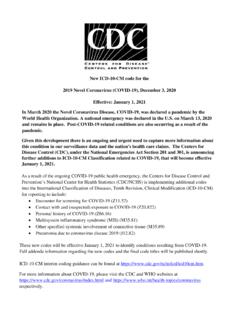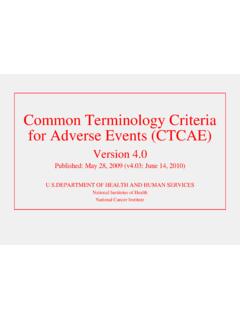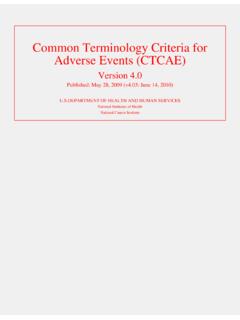Transcription of PATIENT DRIVEN PAYMENT MODEL - Centers for Medicare ...
1 PATIENT DRIVEN PAYMENT MODEL . Fact Sheet: NTA Comorbidity Score Last Revised: 2-14-19. Background Under the Resource Utilization Group, Version IV (RUG-IV) case-mix classification MODEL , nursing and non-therapy ancillary (NTA) costs are addressed under a single component, the nursing component. However, the nursing component does not adequately address variations in NTA costs. Therefore, under the PATIENT DRIVEN PAYMENT MODEL , NTA costs are addressed by a specific NTA component. This fact sheet discusses how patients are classified under the NTA component, specifically calculation of the PATIENT 's NTA comorbidity score. NTA Comorbidity Score NTA classification is determined by the presence of certain conditions or the use of certain extensive services that were found to be correlated with increases in NTA costs for SNF patients .
2 CMS identified a list of 50 conditions and extensive services that were associated with increases in NTA costs. The presence of these conditions and extensive services is reported by providers on the MDS , with some of these conditions being identified by ICD-10-CM codes that are coded in Item I8000 of the MDS. A mapping between these ICD-10-CM codes and the NTA. comorbidities, used for PATIENT classification under the NTA component, is available at One comorbidity, HIV/AIDS, is reported on the SNF claim in the same manner as under RUG-IV. Once a provider knows what conditions and extensive services are present for a given PATIENT , the next step is to calculate the PATIENT 's NTA comorbidity score. Under PDPM, the NTA. comorbidity score is the result of a weighted count of a PATIENT 's comorbidities, rather than using a simple count of comorbidities (which ignores the difference in relative costliness between different comorbidities) or looking at just the most costly comorbidity (which ignores the effect of a PATIENT having multiple comorbidities).
3 To achieve this weighted count, each of the 50. comorbidities used under PDPM for NTA classification is assigned a certain number of points, between one and eight, based on its relative costliness. In order to determine the PATIENT 's NTA comorbidity score, a provider would identify all comorbidities for which a PATIENT would qualify and then add the points for each comorbidity 1. PATIENT DRIVEN PAYMENT MODEL . together. The resulting sum represents the PATIENT 's NTA comorbidity score, which is then used to classify the PATIENT into an NTA component classification group. The table below lists each of the comorbidities used as part of determining the PATIENT 's NTA. comorbidity score, as well as the source of this information and the associated number of points for that comorbidity.
4 Conditions and Extensive Services Used for NTA Classification Condition/Extensive Service Source Points HIV/AIDS SNF Claim 8. MDS Item K0510A2, Parenteral IV Feeding: Level High 7. K0710A2. Special Treatments/Programs: Intravenous Medication Post-admit MDS Item O0100H2 5. Code Special Treatments/Programs: Ventilator or Respirator Post-admit MDS Item O0100F2 4. Code MDS Item K0510A2, Parenteral IV feeding: Level Low 3. K0710A2, K0710B2. Lung Transplant Status MDS Item I8000 3. Special Treatments/Programs: Transfusion Post-admit Code MDS Item O0100I2 2. Major Organ Transplant Status, Except Lung MDS Item I8000 2. Active Diagnoses: Multiple Sclerosis Code MDS Item I5200 2. Opportunistic Infections MDS Item I8000 2. Active Diagnoses: Asthma COPD Chronic Lung disease Code MDS Item I6200 2.
5 Bone/Joint/Muscle Infections/Necrosis - Except Aseptic Necrosis MDS Item I8000 2. of Bone Chronic Myeloid Leukemia MDS Item I8000 2. Wound Infection Code MDS Item I2500 2. Active Diagnoses: Diabetes Mellitus (DM) Code MDS Item I2900 2. Endocarditis MDS Item I8000 1. Immune Disorders MDS Item I8000 1. End-Stage Liver disease MDS Item I8000 1. Other Foot Skin Problems: Diabetic Foot Ulcer Code MDS Item M1040B 1. Narcolepsy and Cataplexy MDS Item I8000 1. Cystic Fibrosis MDS Item I8000 1. Special Treatments/Programs: Tracheostomy Care Post-admit Code MDS Item O0100E2 1. Active Diagnoses: Multi-Drug Resistant Organism (MDRO) Code MDS Item I1700 1. Special Treatments/Programs: Isolation Post-admit Code MDS Item O0100M2 1. Specified Hereditary Metabolic/Immune Disorders MDS Item I8000 1.
6 Morbid Obesity MDS Item I8000 1. Special Treatments/Programs: Radiation Post-admit Code MDS Item O0100B2 1. Highest Stage of Unhealed Pressure Ulcer - Stage 4 MDS Item M0300D1 1. Psoriatic Arthropathy and Systemic Sclerosis MDS Item I8000 1. 2. PATIENT DRIVEN PAYMENT MODEL . Condition/Extensive Service Source Points Chronic Pancreatitis MDS Item I8000 1. Proliferative Diabetic Retinopathy and Vitreous Hemorrhage MDS Item I8000 1. Other Foot Skin Problems: Foot Infection Code, Other Open Lesion MDS Item M1040A, 1. on Foot Code, Except Diabetic Foot Ulcer Code M1040B, M1040C. Complications of Specified Implanted Device or Graft MDS Item I8000 1. Bladder and Bowel Appliances: Intermittent Catheterization MDS Item H0100D 1. Inflammatory Bowel disease MDS Item I1300 1. Aseptic Necrosis of Bone MDS Item I8000 1.
7 Special Treatments/Programs: Suctioning Post-admit Code MDS Item O0100D2 1. Cardio-Respiratory Failure and Shock MDS Item I8000 1. Myelodysplastic Syndromes and Myelofibrosis MDS Item I8000 1. Systemic Lupus Erythematosus, Other connective tissue MDS Item I8000 1. Disorders, and Inflammatory Spondylopathies Diabetic Retinopathy - Except Proliferative Diabetic Retinopathy MDS Item I8000 1. and Vitreous Hemorrhage Nutritional Approaches While a Resident: Feeding Tube MDS Item K0510B2 1. Severe Skin Burn or Condition MDS Item I8000 1. Intractable Epilepsy MDS Item I8000 1. Active Diagnoses: Malnutrition Code MDS Item I5600 1. Disorders of Immunity - Except : RxCC97: Immune Disorders MDS Item I8000 1. Cirrhosis of Liver MDS Item I8000 1. Bladder and Bowel Appliances: Ostomy MDS Item H0100C 1.
8 Respiratory Arrest MDS Item I8000 1. Pulmonary Fibrosis and Other Chronic Lung Disorders MDS Item I8000 1. 3.














